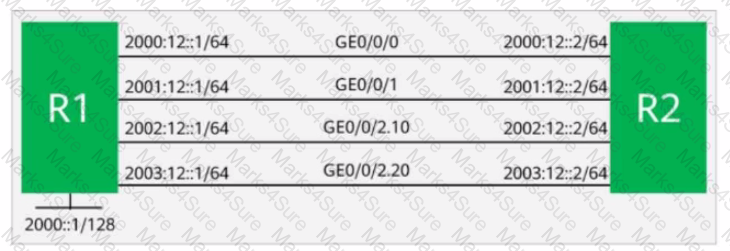On the network shown in the figure, EBGP peer relationships are established between neighboring routers through directly connected interfaces.
The router ID of each router is 10.0.X.X, and the AS number is 6500X, where X is the number of the router.
Both R1 and R4 have static routes to 192.168.1.0/24, which are imported to BGP through the import-route command.
R1 adds a community attribute (1:1) to the route before advertising it to its peers.
All routers are configured to propagate community attributes.
R3 is configured with a routing policy that rejects routes with the community attribute 1:1.
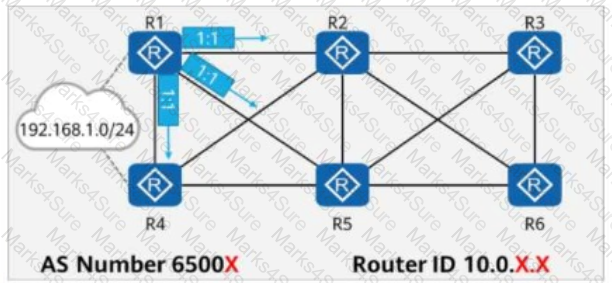
In this case, which of the following is the path for traffic from R3 to 192.168.1.0/24?
OSPF requires that routers in the same area have the same link state database (LSDB). As the number of routes on the network increases, some routers cannot carry so much routing information due to limited system resources. This state is called database overflow. If the Isdb-overflow-limit number 7 command is run on all routers on an OSPF network, which of the following conditions are likely to cause routers to enter the overflow state?
The device operating environment is crucial for stable device operating, including the equipment room, power supply, and heat dissipation. Maintenance personnel must be on site to maintain the device operating environment.
On the network shown in the figure, the network administrator configures the DHCP snooping trust function on the switch.
GE0/0/2 is a trusted interface (connected to the DHCP Server).
GE0/0/3 is an untrusted interface (potential attacker).
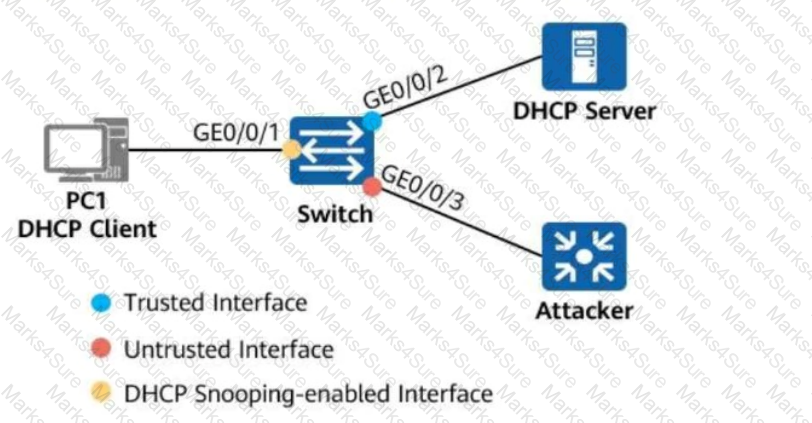
Which of the following statements are true about the two interfaces?
Options:
Service routes of an enterprise are transmitted on the network. Some configurations of PE1 and PE2 are shown in the figure. Which of the following LSAs may CE2 receive?

The figure shows information about VPN1 on a PE (Provider Edge) router in a BGP/MPLS IP VPN network.
When the VPNv4 route corresponding to VPN1 is advertised to the remote PE, which VPNs of the remote PE will accept the route?
VPN1 Configuration:
ip vpn-instance VPN1
ipv4-family
route-distinguisher 100:1
vpn-target 100:1 200:1 300:1 export-extcommunity
VPN Import Policies on the Remote PE:
On the OSPF network shown in the figure, the cost values of links are marked, and OSPF IP FRR is enabled on R1. Which of the following statements is false?
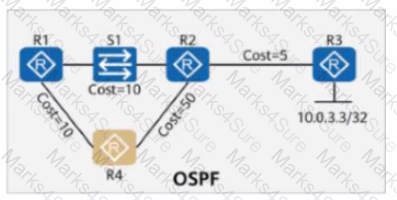
On the network shown in the figure, IS-IS runs on R1, R2, R4, and R5, and the area ID is 49.0001. IS-IS runs on R3 and R6, and the area ID is 49.0002. In AS 65000, R1, R3, R4, and R6 each establish iBGP peer relationships with R2 and R5. R2 and R5 are RRs (Route Reflectors), and R1, R4, R3, and R6 are clients. The iBGP peer relationships are established using Loopback0 on each router, and the router ID is 10.0.0.X/32, where X is the number of the router. R1 and R4 import the external route 192.168.1.0/24 to BGP through the import-route command, and R3 and R6 import the external route 192.168.2.0/24 to BGP through the import-route command. Which of the following statements are true?
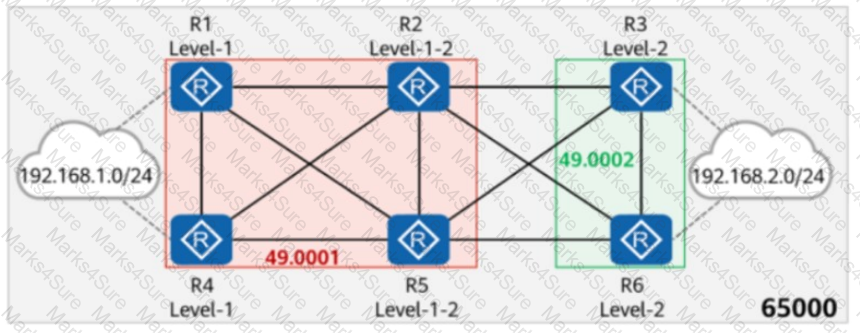
On the network shown in the figure, the network administrator deploys DHCP snooping on the switch to defend against bogus DHCP server attacks.
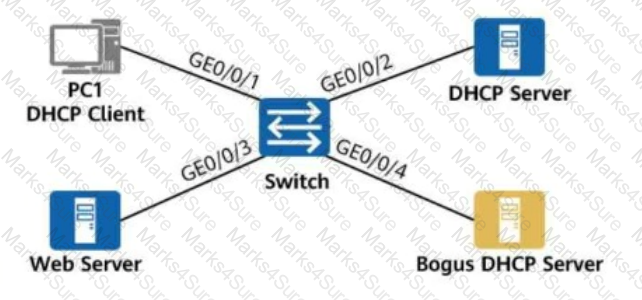
Which of the following interfaces should be configured as the DHCP trusted interface?
If technology migration on the network affects the services running on the live network, strictly follow the preset operation process and risk control measures during the implementation of the technology migration project. Generally, this type of project is defined as a migration project. Which of the following operations performed on the live network belongs to a non-migration project?
On an MPLS network, after an LSR receives a Hello message from a peer, the LSR establishes an LDP adjacency with the peer. The Hello message is sent in multicast or unicast mode.
During an attempt to log in to a NetEngine AR6120 through the console port, the network engineer finds that the password is incorrect and the login fails. If a Telnet account can be used to log in to the device and the account has the permission to change the console port password, the network engineer can log in to the device through Telnet to change the console port password.
On the network shown in the figure, the DHCP server function is enabled on GEO/0/0 of R2, and the address pool is an interface address pool. When GEO/0/0 and GEO/0/1 of R1 function as DHCP clients, only one interface can obtain an IP address by default.

On the IS-IS IPv6 network shown in the figure, multi-topology is enabled on all routers. The IPv6 address of Loopback0 on R4 is 2000::/128. The IPv6 summary 2000::/64 level-1-2 command is configured in the IS-IS processes of R2 and R1. Which of the following statements is false?
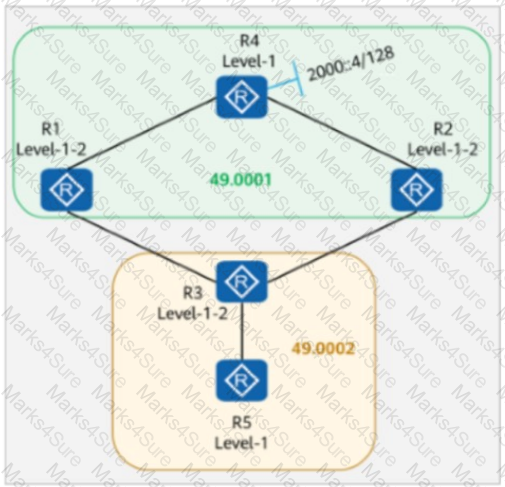
On the OSPF network shown in the figure, area 1 is a stub area, area 2 is a totally stub area, and area 3 is an NSSA. Which of the following routers are unable to import external routes?
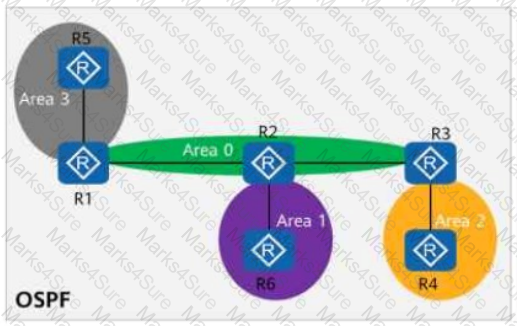
On the IS-IS IPv6 network shown in the figure:
Multi-topology is enabled on all routers.
The IPv6 address of Loopback0 on R4 is 2000::4/128.
The command ipv6 summary 2000::/64 level-2 is configured in the IS-IS processes of R2 and R1.
The command ipv6 import-route isis level-2 into level-1 is configured in the IS-IS processes of R1, R2, and R3.
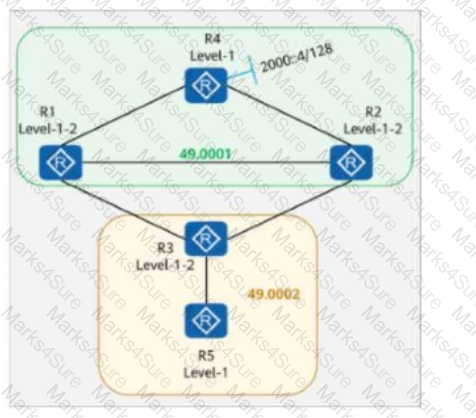
Which of the following routers have the route 2000::/64 in their routing tables?
On the OSPF network shown in the figure, areas 1, 2, and 3 are common areas. The IP address of Loopback0 on R5 is 10.0.5.5/32, and OSPF is enabled on the interface using the network command.
ACL 2000 (with the matching rule shown in the figure) is configured on all routers. If the command filter 2000 import is run in area 0 (where R1, R2, and R3 reside), which of the following routers do not have the route 10.0.5.5/32 in their routing tables?
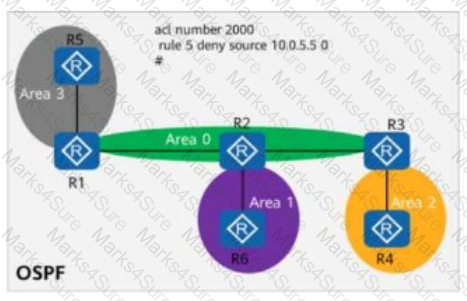
On the network shown in the figure, IS-IS runs on R1, R2, R4, and R5, and the area ID is 49.0001. IS-IS runs on R3 and R6, and the area ID is 49.0002. The import-route isis level-2 into level-1 command is configured on R2.
In AS 65000, R1, R3, R4, and R6 each establish iBGP peer relationships with R2 and R5. R2 and R5 are Route Reflectors (RRs), and R1, R4, R3, and R6 are clients.
The iBGP peer relationships are established using Loopback0. The IP address of Loopback0 on each router is 10.0.X.X/32, and the router ID is 10.0.X.X, where X is the number of the router.
R1 and R4 import the external route 192.168.1.0/24 to BGP through the import-route command, and R3 and R6 import the external route 192.168.2.0/24 to BGP through the import-route command.
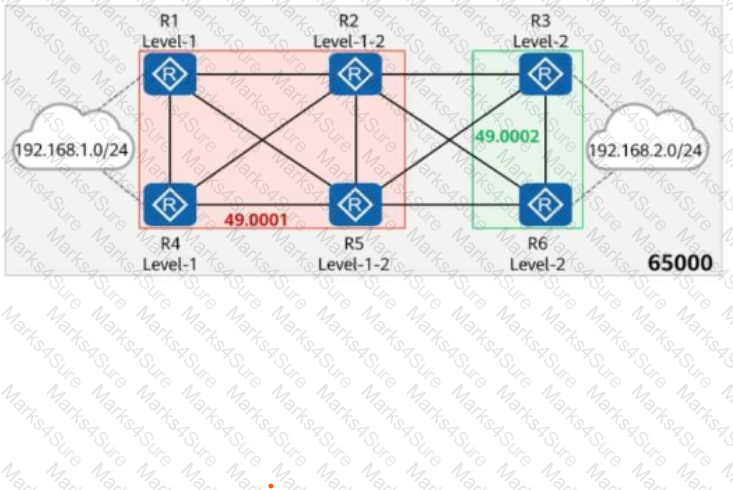
Which of the following statements are true?
On the OSPF network shown in the figure, R1 and R2 are connected through four links. OSPF is enabled on Loopback0 of R2, and the maximum load-balancing 1 command is run in the OSPF process of R1. Which of the following is the outbound interface from R1 to Loopback0 of R2?
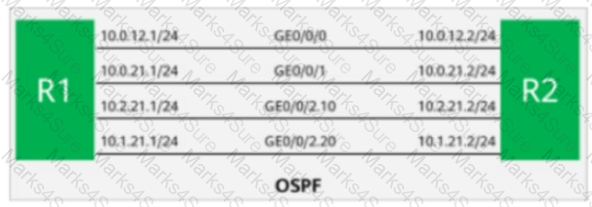
On the OSPFv3 network shown in the figure, area 1 is a stub area. Which of the following statements are true?
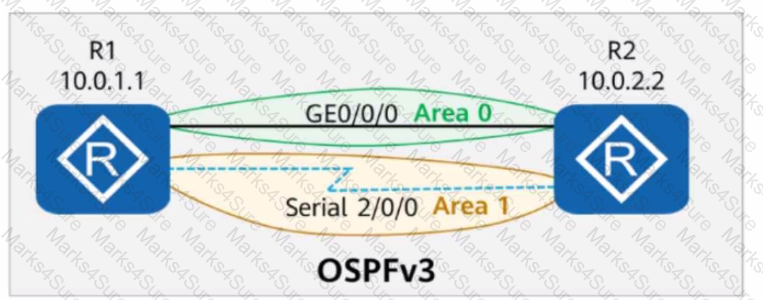
There are multiple types of MAC address entries on a switch. Which of the following entries are manually configured and cannot be aged out?
On a PIM-SM multicast network, a network engineer finds that multicast clients cannot receive multicast data. Which of the following is not a possible cause of this problem?
On the network shown in the figure, IS-IS runs on Rl, R2, R4, and R5, and the area ID is 49.0001. IS-IS runs on R3 and R6, and the area ID is 49.0002. In AS 65000, Ri, R3, R4, and R6 each establish IBGP peer relationships with R2 and R5. R2 and R5 are RRs, and Rl, R4, R3, and R6 are clients. The IBGP peer relationships are established using LoopbackO. The IP address of LoopbackO on each router is 10.0.X.X/32, and the router ID is 10.0.X.X, where X is the number of the router. Rl and R4 import the external route 192.168.1.0/24 to BGP through the import-route command, and R3 and R6 import the external route 192.168.2.0/24 to BGP through the import-route command. Which of the following statements are true?
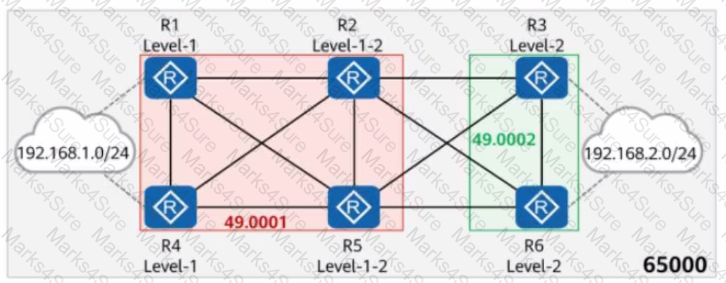
On the OSPFv3 network shown in the figure, area 1 is an NSSA. R1 imports the external route 2000::1/128 to OSPFv3. Which of the following LSAs are available in area 0?
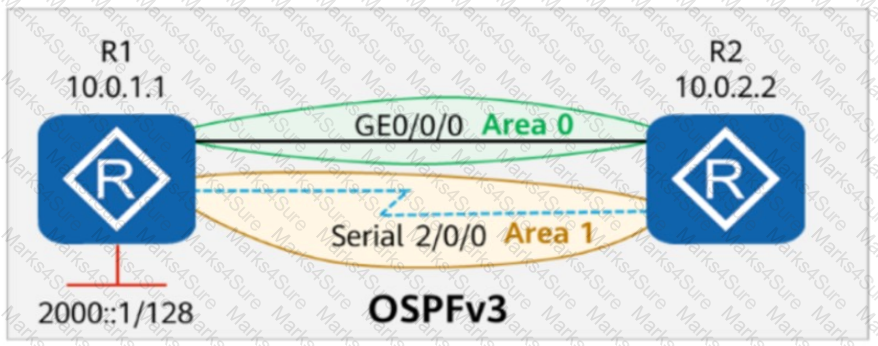
On the network shown in the figure, EBGP peer relationships are established between ASs through directly connected interfaces.
OSPF is deployed in AS 65456 (with OSPF disabled on interconnected interfaces between ASs).
R4 and R5 use Loopback0 to establish iBGP peer relationships with R6.
The IP address of Loopback0 on each router is 10.0.X.X/32, and the router ID is 10.0.X.X, where X is the number of the router.
R1, R2, and R3 import the external route 192.168.1.0/24 into BGP through the import-route command.

Which of the following statements are true?
An administrator runs the display mpls Isp command to view LSPs on a device. The command output is shown in the figure. Which of the following statements are true?
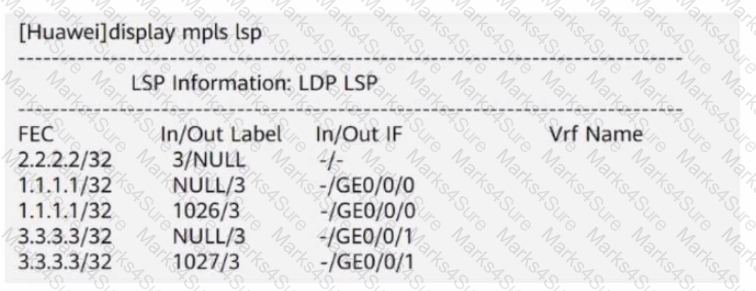
On the OSPFv3 network shown in the figure, OSPFv3 parameters use default values. The LSDB is checked on one of the devices. The router IDs of R1, R3, and R4 are 10.0.1.1, 10.0.3.3, and 10.0.4.4, respectively. The Origin Router part of some LSAs is hidden. Complete this part. (Tokens can be reused.)
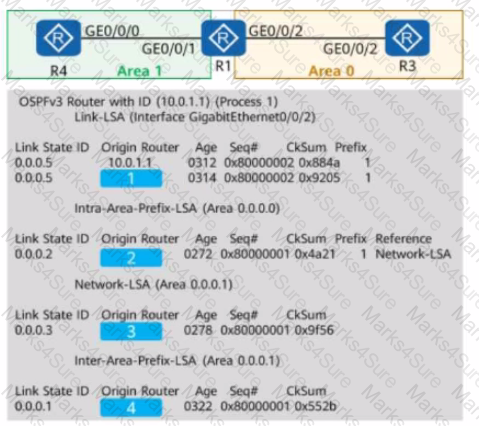

On the network shown in the figure, IS-IS IPv6 runs on R2, R6, and R3, and the IPv6 address of Loopback0 on R6 is 2000::6/128. OSPFv3 runs on other links. Area 1 is a stub area, and Area 2 is an NSSA. IS-IS routes are imported to OSPFv3 on R2 and R3. Which of the following statements are true?
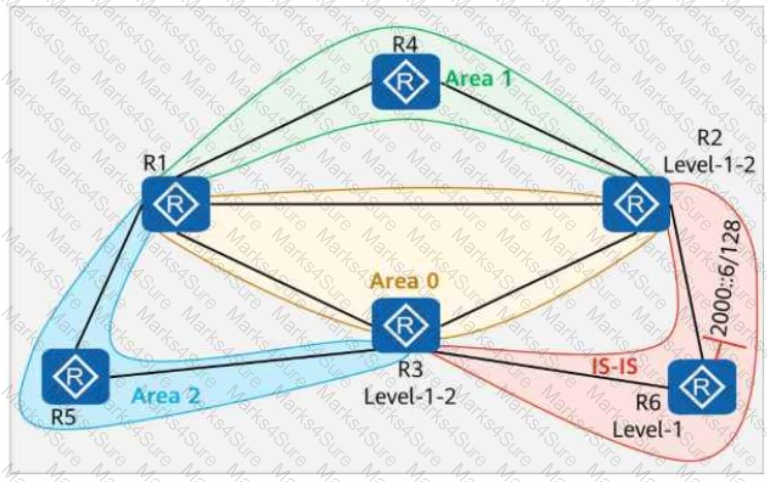
On the OSPF network shown in the figure, the cost values of links are marked. OSPF IP FRR is enabled on R1, and the maximum load-balancing 8 command is configured in the OSPF process. If a service passes through the path R1 → R5 → R3 to reach 10.0.3.3/32, which of the following is the backup outbound interface for the service?
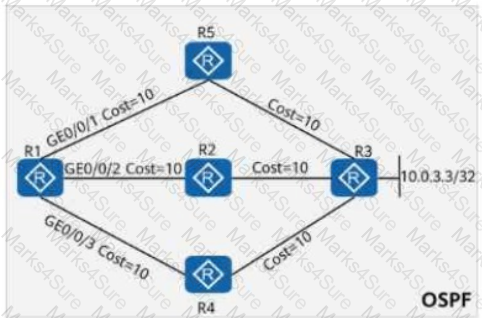
Both VLAN aggregation and MUX VLAN are deployed on the enterprise network shown in the figure.
All switch interfaces connected to terminals are access interfaces.
Given this, match PC1 to PC4 with the hosts or servers they can access on the network.
(Note: A host cannot be matched with itself. For example, PC1 cannot match PC1. Tokens can be reused.)
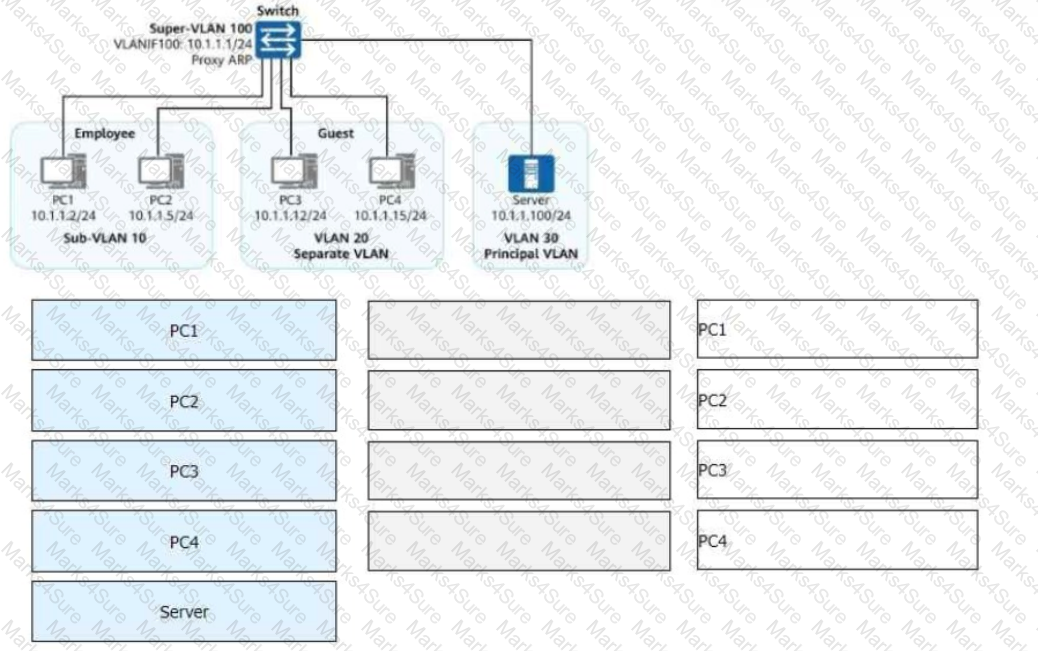
On a BGP/MPLS IP VPN network, which of the following are carried when a PE advertises VPNv4 routes?
On the network shown in the figure, VRRP is configured on Rl and R2, and the virtual IP address is 10.0.12.254. After the configuration is complete, the network engineer checks the VRRP status on R1 and R2, and finds that both devices are in the Master state. Which of the following is not a possible cause of this problem?

On the IS-IS network shown in the figure, R1 imports a default route using the default-route-advertise always level-1 command. Which of the following statements is false?

IPSG is a source IP address filtering technology based on Layer 3 interfaces. It prevents malicious hosts from forging authorized hosts' IP addresses to access authorized network resources.
On the OSPFv3 network shown in the figure, the IPv6 address of Loopback0 on R3 is 2000-3/128, and OSPFv3 is enabled. Which of the following statements are true?
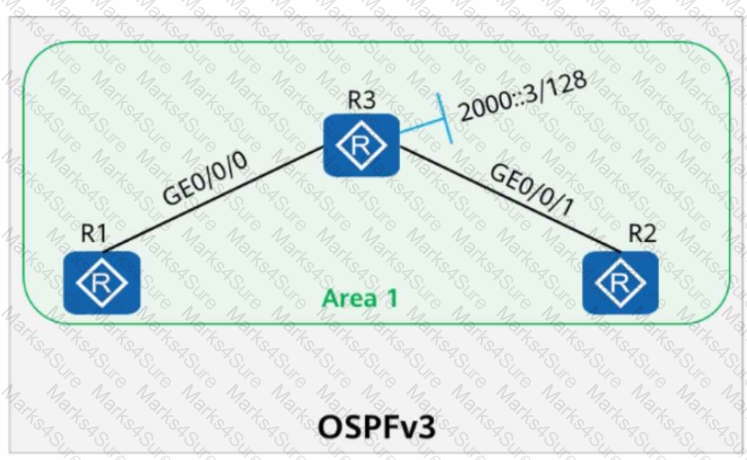
R1 and R2 use directly connected interfaces to establish an EBGP peer relationship. R1 imports 2000:: 1/128 to BGR By default, which of the following is the next hop of the route from R2 to 2000:: 1/128?
